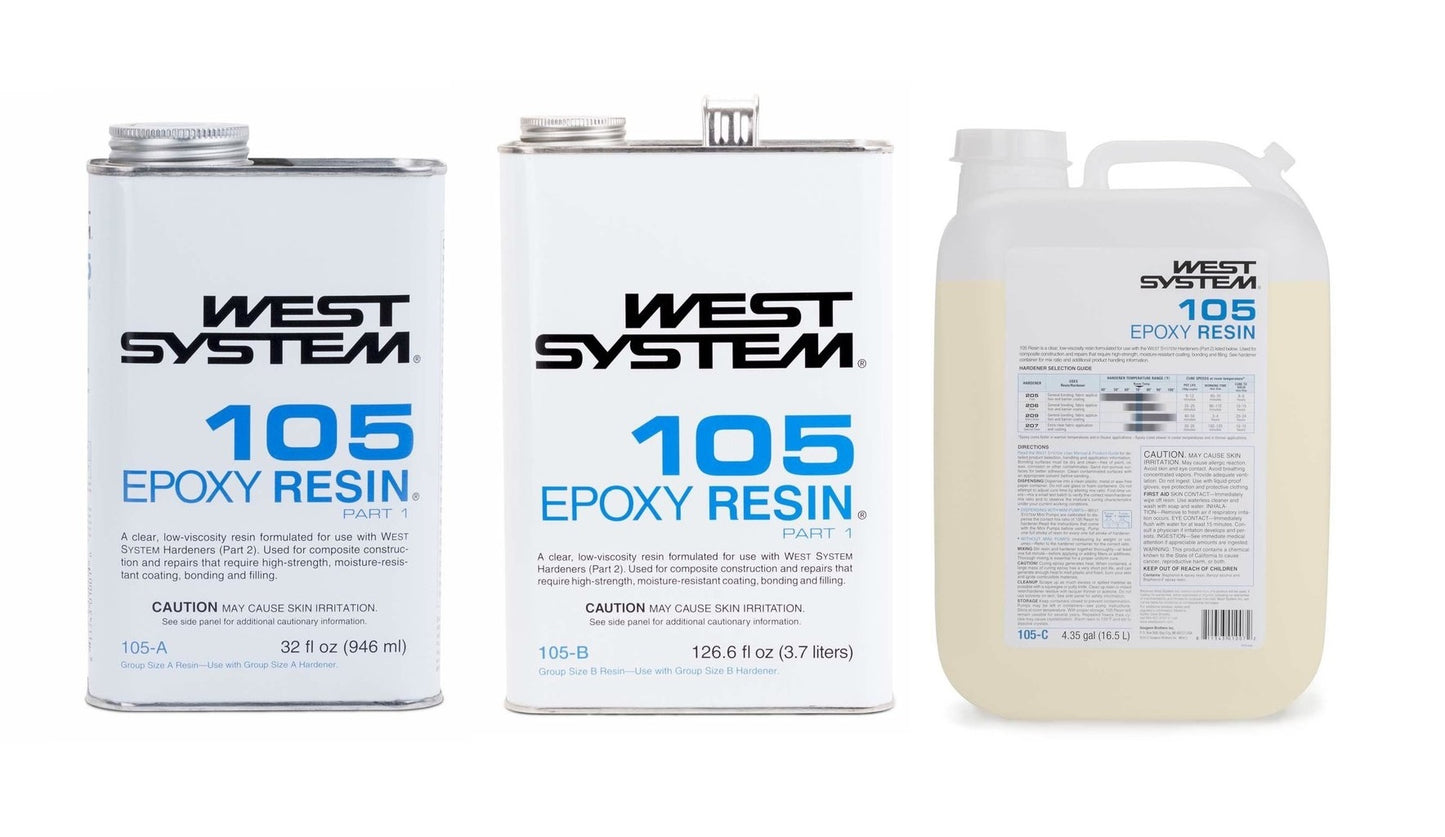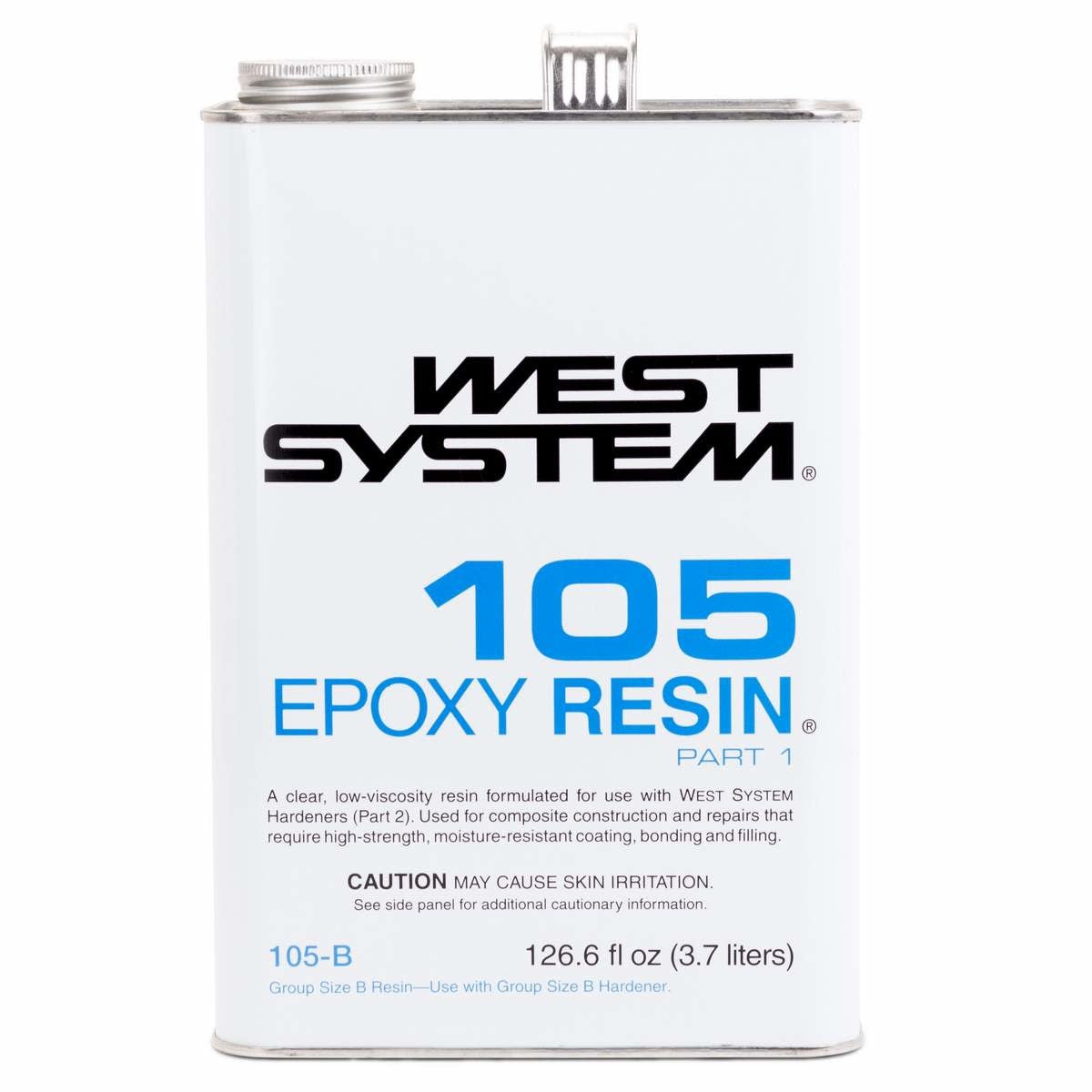West System
105 Epoxy Resin
105 Epoxy Resin
8 in stock
Couldn't load pickup availability
105 Epoxy Resin is the base material on which all WEST SYSTEM 105 System epoxy compounds are built. It is a clear, pale yellow, low-viscosity liquid epoxy resin. Blended with hardener at the proper ratio, it cures to a hard, solid plastic with superior physical properties. Based on which hardener you choose, it cures at a wide range of temperatures. Once cured, it forms a high-strength solid that is functionally waterproof, and highly resistant to moisture vapor.
We designed 105 Epoxy Resin to wet out and bond with wood fiber, fiberglass, and reinforcing fabrics. It also bonds well with a variety of metals.

Epoxy vs. Esters
We’ve formulated 105 Epoxy Resin (and its corresponding hardeners) without volatile solvents. Unlike polyester or vinylester resins, our epoxy virtually does not shrink after curing. With a relatively high flash point and no solvent odor, it’s safer to use than styrenated resins.
Thickening Epoxy
Modifying this epoxy with WEST SYSTEM fillers creates an excellent structural adhesive or fairing compound. You choose the filler that suits your project. Epoxy thickened with adhesive (high-density) fillers makes structural bonds, bridges gaps, and fills voids. Epoxy thickened with fairing (low-density) fillers is easily sanded and shaped after it cures.
Coating
This epoxy is also a great coating material. Applied with a roller, it offers excellent thin-film characteristics. It will flow out and self-level without “fisheyeing.” By combining it with blush-free 207 Special Clear Hardener, you can create a natural finish. You’ll just need to add a couple of coats of varnish for UV protection. This is a good alternative that builds mil thickness quickly, saving time and effort. The results are long-lasting.
105 Resin’s viscosity is approximately 1000 centipoise (cp) at 72 F (22C).
More Facts about WEST SYSTEM Epoxy Using gel coat over WEST SYSTEM 105 Epoxy Resin and Hardener
It’s a myth that if you plan to gel coat over a repair, you must make the repair with polyester. We’ve used gel coat over epoxy for decades. It’s in our fiberglass boat repair videos and discussed it our magazine, Epoxyworks.
There are three key factors for success with gel coat over epoxy:
- Mix your epoxy resin and hardener at the proper ratio (Mini Pumps make this a snap).
- Allow the epoxy to fully cured.
- Before applying gel coat, remove any amine blush from the cured epoxy surface. Amine blush is simply an easily removed wax-like film that can form as a byproduct of the curing process. WEST SYSTEM 105 Resin/207 Special Clear Hardener does not blush.
Gel coat manufacturers shy away from approving the use of non-air inhibited gel coat over epoxy because they’re concerned amine blush will interfere with the gel coat’s cure. All you need to do to remove the blush is wash the surface with plain water. It’s then ready for you to prep for paint or gel coat.
This process is even easier if you use Release fabric. This fabric is applied to uncured epoxy, protecting the surface from contamination. As the epoxy cures, any blush will form on the outside of the release fabric. Simply remove the release fabric after cure, and it will take the blush with it. The resulting surface is ready for you to prepare it for paint or gel coat.
Epoxy’s penetration into wood
Epoxy does more than sit on the surface of the wood. Some epoxy will remain on wood surfaces, and some of it will penetrate into the wood. The amount of penetration depends mostly on how the wood fibers are oriented. Face grain will not absorb nearly as much epoxy as end grain. But since WEST SYSTEM Epoxy is very strong and an excellent adhesive, it strengthens the wood and makes it waterproof.
105 Epoxy Resin batch size and cure speed
You need to know that in larger quantities, epoxy cures much faster. This is because epoxy generates heat as it cures and also cures faster at higher temperatures. This snowball effect increases until the epoxy cures—which in very large batches could take only a couple of minutes. Large pots of mixed epoxy can generate enough heat to cause a runaway exothermic reaction. This can include, smoking, melting the mixing cup or even starting a fire. Spreading epoxy thin allows the heat to dissipate and slows its cure.
Epoxy casting
WEST SYSTEM Epoxy has a very low percentage of shrinkage. In fact, the standards used to calculate shrinkage of other resins (polyester and vinyl ester) aren’t used with WEST SYSTEM because it shrinks so little to measure that way.
When epoxy is used to fill holes drilled into wood, it will soak into the end grain. This might look like shrinkage, but it’s not.
Back in the late ’70s and early ’80s, Gougeon Brothers Inc. manufactured over 4,000 wind turbine blades and their molds using WEST SYSTEM Epoxy. It was commonplace to see a 70-foot long mold shrink 3/32″ over the entire 70-foot length. That represents shrinkage of just .01% on a laminate consisting of fiberglass and WEST SYSTEM Epoxy.
Avoiding exotherm when casting
When casting epoxy, heat buildup can become an issue. Excessive heat can make WEST SYSTEM Epoxy can shrink some. Pouring epoxy in great depths creates the potential for the epoxy to get very hot due to the exothermic reaction resin and hardener have. While exotherm is a normal part of the curing process, you must always keep it under control. Do this by using smaller pours when casting, and working in a cool environment.
Any shrinkage that does occur generally happens while the epoxy is still liquid, but when an intense amount of heat is present, epoxy doesn’t stay liquid for very long. As the heat dissipates, the difference in temperature between the top and bottom of the casting can shock the now solid epoxy and it may crack. To avoid this, make deep castings in layers.
Adding extra hardener (don’t)
While adding extra catalyst to polyester resins can lead to a faster cure, you should never add extra hardener to epoxy resin. Epoxy reaches cure when the resin molecules cross-link with hardener molecules. When there is too much of either resin or hardener, unlinked molecules are left over. This can result in uncured epoxy or compromised cure strength. Always mix epoxy resin and hardener as close as you can to the recommended ratio.
Clamping force
Unlike traditional wood glues, WEST SYSTEM Epoxy is stronger than wood. Because of this, it is beneficial to have some epoxy between the objects you are gluing together whether they are wood, fiberglass, or other materials. As long as the epoxy is contacting the entire surface of both substrates, no clamping pressure is needed.
The goal clamping is to simply ensure the epoxy contacts the entire surface for the duration of the cure time. Moderating clamp force is all you need. If you aren’t using a filler, and apply too much clamping force, this can result in a glue-starved joint. This makes future joint failure much more likely. Glue starved joints are weaker than their counterparts. Avoid glue-starved joints by following the one- or two-step bonding method.
Filler and Epoxy Strength
While certain fillers will increase the density of epoxy, this does not correlate to higher physical properties or increased adhesion strength. Epoxy is strongest without filler added to it, but the fillers are necessary to:
- Increase the viscosity of the mix
- Bridge gaps
- Prevent the epoxy from soaking too far into the wood
- Prevent glue-starved joints
Epoxy and Rotted Wood
Rot eats away the cellulose fiber in wood. Cellulose is the structure of the wood. Replacing it is not as simple as brushing on a coat of solvent-thinned epoxy. Solvented epoxy may replace some of the strength, but isn’t a permanent repair—it won’t restore the strength of the wood fibers. To make a permanent repair, replace the entire rotten area with fresh wood and sealed with epoxy. Addressing rot this way will make the repair area stronger than it was before the rot occurred.
Why remove rot?
Rot needs four major components in order to continue growing:
- Food
- Moisture
- Oxygen
- Warmth
Cutting off just one of these components is enough to cause the rot to go dormant. Solvented epoxies are supposed to cut off rot’s food source by encapsulating and contaminating the wood that the rot spores consume. However, the remaining three components: moisture, oxygen, and warmth, can still penetrate wood coated with solvented epoxy.
This is because solvented epoxy is a poor moisture barrier. Rot spores will remain in the wood, and even when encapsulated in solvented epoxy, they will only go dormant. Un-isolated rot pores will continue devouring the cellulose, causing more rot.
This is why we recommend removing the rotten wood and replacing it with fresh wood that is sealed with several coats of WEST SYSTEM Epoxy.
Over time, 105 Resin will thicken slightly and will therefore require extra care when
mixing. Repeated freeze/thaw cycles during storage may cause crystallization of 105
Resin. Warm resin to 125°F and stir to dissolve crystals. Hardener may darken with age,
but physical properties are not affected by color. Be aware of a possible color shift if very
old and new hardener are used on the same project.
Share




- Choosing a selection results in a full page refresh.
- Opens in a new window.



